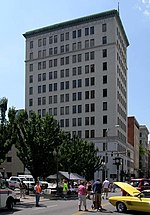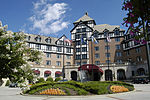Roanoke City Market Historic District

Roanoke City Market Historic District, also known as City Market District, is a national historic district located in the Downtown Roanoke area of Roanoke, Virginia. The district's history dates to 1882, when the Norfok and Western Railway (N&W) began the process of locating its headquarters to the small town of Big Lick. That decision precipitated a name change for the town to Roanoke, as well as a migration of the town's business district southeast towards the new railroad depot and hotel being built by the N&W. A town square along Campbell Avenue began seeing use as a makeshift open-air market, and in 1884 the new City of Roanoke's original charter provided for the construction of a municipal market. Completed in 1886, the original market building occupied the northwestern portion of the square; when that building was destroyed by fire it was replaced in 1922 with the current building and its centered arrangement.It was listed on the National Register of Historic Places in 1983, with an area roughly bounded by Williamson Rd., Norfolk Ave., S. Jefferson St., and Church Ave. The district area was increased to include 302 Campbell Ave., SE, and 9 Church Ave, SE, in 2002. The district encompasses 51 contributing buildings and 1 contributing object. The focal point of the area's grid-plan is the City Market Building (1922) set in the middle of the central Market Square. Other notable buildings include the Hartsook Building (1897), Lampros Building (1909), the McGuire Building (1914), and the Goria Brothers Grocery Building (1924). Located in the district is the separately listed Fire Station No. 1.
Excerpt from the Wikipedia article Roanoke City Market Historic District (License: CC BY-SA 3.0, Authors, Images).Roanoke City Market Historic District
Kirk Avenue Southeast, Roanoke Morningside
Geographical coordinates (GPS) Address Nearby Places Show on map
Geographical coordinates (GPS)
| Latitude | Longitude |
|---|---|
| N 37.271666666667 ° | E -79.939166666667 ° |
Address
Roanoke City Market
Kirk Avenue Southeast
24011 Roanoke, Morningside
Virginia, United States
Open on Google Maps











